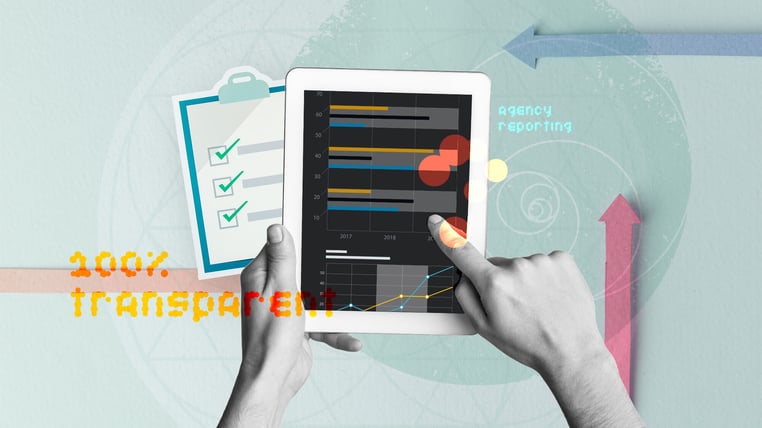In today's data-driven world, reporting and analytics are two terms that are commonly used interchangeably. However, despite their similarities, there are distinct differences between the two. Understanding these differences is essential for businesses to make informed decisions and drive their growth.
The Key Differences Between Analytics And Reporting
Reporting is a vital component of business intelligence. We use reports to keep track of key performance indicators (KPIs) such as sales, revenue, and expenses. Reporting is the process of collecting and presenting data in a standardized format. This data is often historical and provides an overview of what has already happened. Reports are typically static and generated regularly, such as weekly or monthly.
On the other hand, analytics is the process of examining data to extract insights and make informed decisions. Analytics is a more complex process that involves data exploration, statistical analysis, and modeling. Analytics goes beyond reporting by providing a deeper understanding of the data and its implications. Analytics is also more focused on predicting future trends and outcomes rather than just summarizing historical data.
Simply put, reporting provides a snapshot of the past, while analytics offers a roadmap for the future.
Finally, note that analytics is also more customizable than reporting. Reports are typically generated from a pre-defined set of data. Analytics can drill down into specific business areas, such as sales by product or region, and provide deeper insights into those areas. At the same time, analytics can be customized to meet specific business needs.

Why the confusion?
People often confuse analytics and reporting in marketing because the terms are used interchangeably, even though they refer to different things.
Reporting in marketing is the process of gathering and presenting data about marketing performance. It typically involves summarizing data in tables, graphs, or charts and presenting it in a clear and understandable format. Reporting can provide information about what happened in the past, such as the number of leads generated from a marketing campaign, the number of website visits, or the click-through rate of an email campaign.
On the other hand, analytics in marketing involves using data to identify patterns, trends, and insights to make informed decisions about future marketing strategies. Analytics involves applying statistical and mathematical techniques to data to identify cause-and-effect relationships and predict future outcomes. This may include exploring data to find connections between various metrics, testing hypotheses, or creating predictive models.
The confusion between analytics and reporting often occurs when reports are presented as if they were analytics.
As a simple example, if a marketing report shows that a particular marketing campaign generated a high number of leads but did not explain why or what factors contributed to this success, it is simply reporting. However, suppose the report also analyzes the campaign data to identify which channels, tactics, or messages were most effective. In that case, this is an example of analytics.
To distinguish between reporting and analytics in marketing, remember that reporting provides valuable information about past performance. Analytics helps businesses make better decisions based on data-driven insights about the future.
Here are three examples of analytics and three examples of reporting:
Analytics:
- Customer segmentation analysis involves analyzing customer data to identify customer segments based on behavior, demographics, or other characteristics. The insights gained from this analysis can then be used to create targeted marketing campaigns or optimize product offerings to meet each segment's needs better.
- Predictive analysis involves using statistical algorithms and machine learning techniques to analyze customer data and identify patterns and trends that can be used to make predictions about future customer behavior.
- Sentiment analysis involves analyzing customer feedback from social media, surveys, or other sources to identify patterns and trends in customer sentiment. The insights gained from this analysis can then be used to improve customer service, product development, or other business areas.
Reporting:
- Sales reports - This involves summarizing sales data over a specific period, such as daily, weekly, or monthly. The report may include information on total sales, sales by product or region, and other key metrics.
- Financial reports - This involves summarizing financial data, such as revenue, expenses, and profit and loss, over a specific period. The report may include information on cash flow, balance sheets, and other financial metrics.
- Marketing reports - This involves summarizing data related to marketing campaigns, such as website traffic, email open rates, and conversion rates. The report may include information on the effectiveness of each campaign, allowing the business to adjust its marketing strategy accordingly.
Gaining Insights
You can gain powerful insights by correlating your marketing reports with your analytics.
Let's say a business has identified three customer segments through its segmentation analysis: young adults, families with children, and retirees. The business is running a marketing campaign promoting a new product that appeals to families with children. They have created separate advertising campaigns targeting each of the three segments.
To analyze the effectiveness of the campaigns, the business can generate marketing reports that provide data on how many clicks, conversions, and sales each campaign generates. The company can then use this data to see which campaigns are performing well and which are not.
By correlating the marketing reports with the customer segmentation analysis, the business can also see how each campaign performs with each customer segment. For example, the company may find that the campaign targeting families with children generates the highest click-through rates and conversions, while the campaign targeting retirees is not performing as well.
With this information, the business can adjust its marketing strategy to focus more on the successful campaign and make changes to the less successful campaigns. The company can also adjust its product offerings to better meet the needs of each segment based on the insights gained from the customer segmentation analysis. By using both marketing reports and customer segmentation analysis together, the business can make more informed decisions and optimize its marketing strategy for maximum effectiveness.
 Another example of correlating reporting and analytics is one we at Remark use frequently—predictive analysis and sales reporting to analyze the effectiveness of a marketing campaign by predicting how it will impact sales.
Another example of correlating reporting and analytics is one we at Remark use frequently—predictive analysis and sales reporting to analyze the effectiveness of a marketing campaign by predicting how it will impact sales.
Let's say your business has launched a new marketing campaign to promote a product. You can generate a predictive model that analyzes customer data to predict how the campaign will impact sales. The predictive model takes into account factors such as your customer's demographic information, previous purchase history, and online behavior to predict how likely they are to purchase the product as a result of the marketing campaign.
To analyze the effectiveness of your marketing campaign, you can correlate the predictive analysis with sales reports. The sales reports will show how many units of your product were sold before and after the marketing campaign. By comparing the sales data with the predictions from the predictive model, you can determine how accurate the predictions were and how effective the marketing campaign was in driving sales.
For example, you may find that the predictive model accurately predicted a 10% increase in sales due to the marketing campaign and that the actual sales data shows a 12% increase. You will use this information to determine the marketing campaign's effectiveness and make adjustments to future campaigns. If the predictions are inaccurate, the business can adjust its predictive model to improve the accuracy of future predictions.
By correlating predictive analysis in marketing with sales reports, you can make data-driven decisions and optimize marketing efforts for maximum effectiveness. It allows you to predict the impact of marketing campaigns on sales and adjust your strategies accordingly to improve performance.
The Essential Nature Of Reporting In Marketing
Reporting is critical in marketing. It allows you to measure the success of your marketing campaigns, track their marketing performance over time, and make informed decisions based on data-driven insights.
Marketing reports provide your business with a wealth of information about the effectiveness of its marketing efforts. Use them to find insights into how many leads and sales were generated from a marketing campaign, how much was spent on the campaign, which marketing channels were most effective and much more. Then use this information to determine a marketing campaign's return on investment (ROI) and identify areas where improvements can happen.
Reporting also empowers your to identify trends and patterns in your marketing data. For example, a business may notice that sales tend to increase during certain times of the year or that certain products are more popular with specific customer segments. Optimize marketing campaigns, adjust product offerings, and improve targeting strategies with these insights.
In addition, reporting is essential for communicating marketing results to stakeholders within the business. Share your marketing reports with management, sales teams, and other stakeholders to help them have a clear picture of how the marketing efforts are performing. In this way, you can help to build support for marketing initiatives and secure additional resources for future campaigns.
Overall, reporting is a critical component of marketing. It gives you the insights and information they need to make informed decisions, optimize their marketing strategies, and drive success. By measuring and tracking marketing performance over time, businesses can improve their marketing efforts, better target their customers, and ultimately achieve their marketing goals.

What To Expect From Your Agency's Reports
When working with an agency, it is crucial that reporting is 100% transparent. Transparency in reporting means that the agency provides clear and accurate information about the performance of your marketing campaigns without withholding any information or hiding any issues.
Transparency in reporting is essential for building trust between the business and the agency. When the agency provides complete and accurate reporting, it demonstrates that they are accountable for its work and committed to delivering results. It also allows the business to make informed decisions based on the data and to adjust its marketing strategies accordingly.
In addition, transparency in reporting helps to identify areas where they can make improvements. Suppose the agency is not transparent in its reporting. In that case, it may be difficult to identify issues or problems with the marketing campaigns. With transparent reporting, you can work with the agency to address the issues and optimize the campaigns for better performance.
Overall, when working with an agency, transparency in reporting is essential. It enables the business to make informed decisions, identify areas for improvement, and build trust with the agency. By providing clear and accurate reporting, the agency can demonstrate its commitment to delivering results and helping the business achieve its marketing goals.
Formats of Reporting
Marketing reports come in various formats, depending on the needs and preferences of the business and its stakeholders. Here are some of the different mediums in that marketing reports can be delivered:
- PDF or Word documents: Marketing reports can be in standard document formats like PDF or Word, which can be easily shared with stakeholders via email or file-sharing services.
- PowerPoint or Keynote presentations: Reports can be presentations in programs like PowerPoint or Keynote. This format is helpful for engagingly presenting key findings and data and can be used for meetings or workshops.
- Dashboards: Dashboards are a visual way to display data in real time and can be created using business intelligence software or other data visualization tools. They are often used to track key performance indicators (KPIs) and are visible to stakeholders online. Remark's RADAR dashboard fully integrates any essential data format and helps you quickly find insights from the reports.
- Infographics: Infographics are a visually appealing way to present data and statistics. They are often used to summarize complex data and make it easy to understand. Infographics can be shared via social media, email, or as part of a larger report.
- Video presentations: Video presentations can be used to present marketing data and insights engagingly and entertainingly. They can be shared on social media or presented at meetings or events. These reports work well with a Powerpoint presentation and can be produced quickly with recording software like Loom.
- Interactive reports: Interactive reports allow stakeholders to engage with the data and explore different aspects of the report. They can be created using tools like Tableau or Power BI and are accessible online.
These are just a few examples of the different delivery mediums of marketing reports. The format used will depend on the goals of the report, the preferences of stakeholders, and the type of data being presented.
In closing, remembering the differences between analytics and marketing reporting can be a challenge. Still, it's crucial to understand your data and drive success. Here are a few tips to keep in mind: Analytics is focused on data analysis and interpretation. In contrast, reporting is focused on summarizing and presenting that data clearly and concisely. Analytics involves exploring trends and patterns while reporting delivers insights and recommendations based on those trends.
To get the most out of your data, it's necessary to use both analytics and reporting in your marketing strategy and choose the proper reporting format for your team and stakeholders. By keeping these tips in mind, you'll be well on your way to unlocking the power of marketing reporting and analytics. As always, if you have questions about structuring your data into valuable reports or are unsure of what data to focus on, reach out to us so that we can help you.
